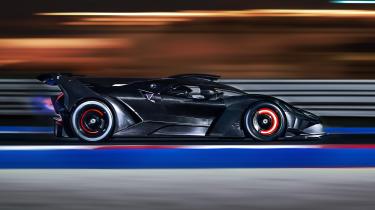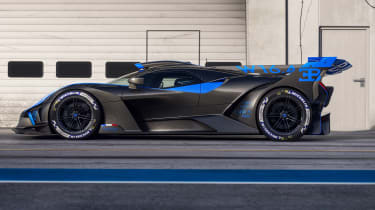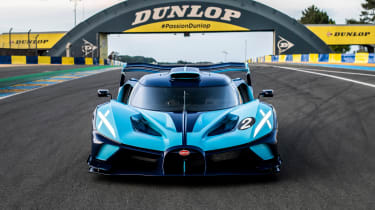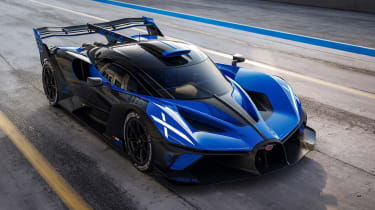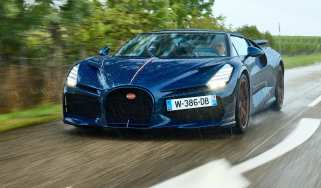The Bugatti Bolide is a £3.5m, W16-powered track-only hypercar
With more power and less weight than its road-going relative, the Bugatti Bolide is set to be the most extreme take on the W16 hypercar yet
Initially unveiled as an exotic, far-fetched concept, the Bolide has since become Bugatti’s most ambitious project to date. In 2021, the marque announced that it would put the track-only W16 hypercar into limited production, embarking on a three-year development programme ahead of first deliveries later this year. Pairing its iconic quad-turbocharged W16 powertrain with a bare-bones, lightweight body, each of the 40 examples will cost its buyer from c£3.5m.
After two years of development, Bugatti has now revealed details of the Bolide's bespoke Brembo braking system. Said to be the largest carbon-carbon automotive setup ever produced, the model is equipped with eight-piston aluminium monobloc calipers on the front axle, acting upon 390mm carbon discs – the rear axle features a similar setup, only with six-piston calipers and marginally thinner 390mm discs. Despite the stopping power on offer, each disc weighs just 3.1kg, with even the master cylinders and brake fluid bespoke to the model. These specs put the Bolide's braking system in-line with those used in Formula 1 and the Le Mans Hypercar programme.
> Aston Martin Valkyrie review: a new realm of hypercar performance
Mario Almondo, Chief Operating Officer of Brembo Performance, said: '...We had to reengineer the entire system to cope with the incredible yet demanding characteristics and power of the car. The front caliper, for example, is a real masterpiece of engineering in my view, being the largest we have ever fitted to a racing car. Using carbon compounds that are similar to those in Formula 1 meant that, despite the size and power of the Bolide, we were able to produce the lightest possible design.'
Engine, transmission and technical details
At the Bolide's core is Bugatti’s 8-litre quad-turbocharged W16, sending 1578bhp and 1180lb ft of torque to those Michelin slicks – unlike a Chiron, the Bolide will lean on all four of its turbochargers at all times, and feature a higher red line. The lighter, more powerful concept was said to cover the 0-62mph sprint in only 2.17sec and hit a top speed of over 310mph, but we’ll have to wait for figures for the production car. The concept was also said to go from 0 to 249mph and back to standstill in just 24.64sec, 6.84sec faster than the current record holder, Koenigsegg’s Regera.
To ensure the unit can withstand the toils of a track session, Bugatti has optimised its cooling and oil systems whilst also upgrading the four turbochargers to produce more boost at higher engine speeds. A total of three air-cooled charge coolers are employed to help keep the engine, transmission and differential at within suitable operating temperatures, and there’s also a water pre-cooling system there to give the system a helping hand too.
The Bolide’s real party piece is that 1450kg kerb weight, astonishing considering the immense near-500kg weight of the powertrain. To streamline the weight as much as possible, Bugatti switched from water-to-air cooling to air-to-air, utilised 3D-printed titanium components throughout, including a wound carbonfibre driveshaft, forged magnesium wheels and a completely stripped cabin.
Suspension is of a pushrod design with the horizontal dampers visible through apertures in the bonnet. Extreme aerodynamics were also high on the agenda, with a peak downforce rating at 199mph reaching 1800kg on the rear axle and 800kg at the front. A ‘morphable outer skin’ is also used for the roof-mounted intake, altering the surface texture at speed to reduce drag by 10%. Bugatti claims that this all allows the Bolide to achieve an incredible lateral acceleration of 2.8G.
Recent rounds of testing saw the Bolide undergo real-world aerodynamic assessment, with its extreme front splitter, rear diffuser and adjustable rear wing put through their paces. With most of these components shaped by mathematics in simulations, Bugatti is now ensuring the hypercar performs on track, and predictably for drivers of varying skill levels. This doesn't mean it's any less potent though, with initial tests proving that it can achieve 2.5G of lateral acceleration in cornering.
Remarkably, Bugatti believes it can come close to matching the figures announced for the concept in 2020. Running on more readily-available 98 RON fuel as opposed to the 110-octane of the concept, peak power is down from 1825bhp to 1578bhp, but this still makes it 100bhp more powerful than the most potent iteration of the W16 so far. Should it meet these targets, the Bolide will achieve an astounding power-to-weight ratio of 1106bhp/ton.
The low kerb weight is achieved through a vast spread of weight-saving techniques, including the application of 3D printing and biomimicry. Such technologies have been applied to elements like the mounting hardware for the car’s aero, which features a patented construction similar to that of bone. Printed in titanium, each component has thin outer walls and a complex hollow structure inside, something that only additive manufacturing techniques like 3D printing can achieve. The similarly constructed suspension pushrods are able to transfer up to 3.5 tons of force, despite weighing just 100 grams, displaying an astonishing mass-to-strength ratio. This same technology is applied to small components throughout the Bolide, such as the wheel-mounted turbofans cooling the 390mm (front) carbon-carbon brakes and load-bearing aero components.
Design
Previously spied testing at Circuit Paul Ricard in France, the Bolide bears little resemblance to its road-going siblings, with a set of proportions that differ markedly from the Chiron. Bugatti’s trademark horseshoe grille does make an appearance, but fronts an entirely new body which has been designed with weight savings, aerodynamics and cooling in mind. Sitting just 995mm off the ground, the marque says its design is reminiscent of the famous Bell X-1 aircraft piloted by Captain Charles ‘Chuck’ Yeager, the first person to break the sound barrier.
At the rear, a complex, stacked rear wing setup can be found, with a central fin mounted on the engine cover likely there to increase stability. An aggressive new diffuser, rain light and mammoth 400-section LMDh-spec Michelin slicks are also clear to see; for reference, the Chiron is fitted with 355-section rear tyres.
Interior
With its X-themed cabin inspired by high-level motorsport, Bugatti has taken advantage of the Bolide's new monocoque by offering a rearward-leaning seating position, with the driver’s feet raised. The removable yoke-style steering wheel has had its ergonomics painstakingly fettled following driver feedback to ensure quick, easy access to its eight buttons even when pushing on. Not a single interior component is shared with the Chiron, with even its climate control system made just for the Bolide for weight savings.
Mounted directly to the monocoque for optimised packaging and a reduction in weight, the Bolide is the first ever Bugatti with fixed seats – the driver will instead adjust the steering wheel and pedals, as we’ve seen in the likes of the Ford GT and Ferrari SP3 Daytona. Like some racers, even sections of its seat padding are mounted to the door for packaging purposes.
Bugatti is now coming towards the end its three-year development programme for the car, with the first of 40 examples scheduled for delivery later this year. Prices start at c£3.5m.
